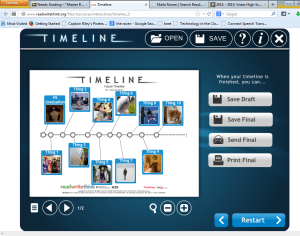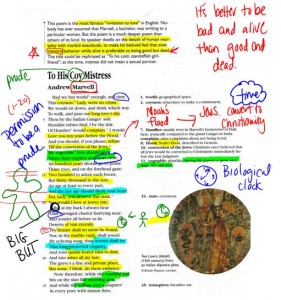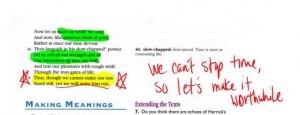Pretty easy class today. I just gave you time to finish your Obituaries and then flex time to work on any missing assignments.
Priority goes to the Obituary – that’s 150 points, yo! Then the Obit Mentor Sentences!
We reviewed what we read yesterday by adding information to the foldable that we made yesterday. We added information about Hrothgar and Beowulf.
We read The Coming of Beowulf today – wow. What I can I say about Beowulf? He’s pretty awesome.
He really represents the values of the Anglo-Saxons. We talked about the difference between being COCKY and CONFIDENT – and that Beowulf was confident.
We also discussed why it was significant that Beowulf asked Hrothgar for permission to kill Grendel rather than busting in and kill stealing.
Then, I gave you some flex time to either work on missing assignments (MSG = a zero in the gradebook!) or to work on the Metaphorical Response.
Today, we just worked on our Obituary in class. It was pretty much a shut up and work day.
It will be due tomorrow, and we’ll have a little time to work on it in class, and we’ll be doing a foldable with it as well.
Remember – if you get stuck, use the examples in the Blog of Death and the student examples in BB. You don’t have to live a crazy life in order to carpe diem – just think about the legacy that you want to leave.
Oh, and just in case you think obituaries have to to be serious in tone, here is the SELF-PENNED obit of a man who had FUN writing his obituary.
We started out making a foldable – just making it. We will add little bits to it each day after we read.
Today we started reading Beowulf. We will read just one section a day, so that means if you find the poem boring (I didn’t write it – it doesn’t hurt my feelings!), I won’t commit readicide on you by making you read for all 80 minutes of class. You can thank me later.
Today, we skimmed the background notes and read The Wrath of Grendel.
We spent some time talking about mead, the mead hall, and Bass Shandy soda.
If you weren’t here, you missed watching me jump on desk growling and you missed me harassing students with “Grendel”. Read this on your own and be familiar with it.
Then, we played a game called Tribond. We were given 3 different pictures of unrelated objects and we had to figure out what they all three had in common. If you liked playing this game, here is a new puzzle for each day!
Then, I explained why we played that game: the Metaphorical Response! A metaphor is a comparison between two UNLIKE things.
A metaphor is a comparison between two unlike things not using the word “like” or “as” to make the comparison. The greater the difference between the two things being compared, the better the metaphor. For example, if one were to say that “Football is baseball,” that would not be a good metaphor, because football and baseball are both sports. However, if one were to say that “football is chess,” that would generally be considered a better metaphor because there is a greater difference between football and chess than football and baseball.
That webpage has fifty good examples of metaphors, like this: The typical teenage boy’s room is a disaster area.
So, you’ll be finding a metaphor for the ten elements on the worksheet and explaining it. If you need help, check out the example in BB.
You only need to have ONE quote – not two or three like the example shows.
Just make sure that you use good metaphors.
For example (and don’t use this one), Grendel is nasty. No one likes him. No one wants him around, but no one can stop him.
Column 1: Grendel is like a SBD (silent but deadly fart).
Column 2: SBD farts are silent and sneak up on you. They are very powerful, and take down everyone within sniffing zone. The only way you can survive a SBD is if you run away! Not only are they silent, but you can’t see them.
Column 3: Grendel is very strong, and no one can defeat him. No one likes him, no one wants him around, but no one can figure out how to deal with him or get rid of him. Anyone who goes up against him, is destroyed. Just like a SBD, the only way you can survive an attack with Grendel is if you run away. Because Grendel hunts at night and the only survivors are those who flee, no one has ever seen Grendel, either!
Column 4: One quote that proves your comparison. Since we used a PDF file for Beowulf, you can’t copy and paste, so you’ll need to type it manually.
We also talked a little about what the name Beowulf means. This is what I found:
Even though Horace warns us not to, we are going to look at our long term goals today. In doing so, we can identify the short term goals we need in order to reach the BIG goals. Capiche?
There is a link in BB that will take you here:
So, you’ll start out here. All you need to do here is add your name and the title Future Timeline. and then hit start.
Here, you’ll add your first item. Click on the timeline to see this screen. All you need focus on are the label and the picture. Don’t worry about adding the short or the long description – this is just a pre-writing activity for ideas. You’ll do the writing about it during the Obituary, which we are starting today!
When you are done, it should look something like this, except yours will be real items. ![]()
If you have to quit BEFORE you are done, you’ll hit SAVE at the top and save it as a RWT file. This is a rough draft. You can’t turn this in.
When you are done, you’ll hit finish and see this screen. Then, you’ll hit SAVE FINAL.
Save this as a PDF and turn this bad boy in.
Today, we started out by talking about obituaries in general. They are the written notices of death that usually include a brief biography of the person. Then we read the poem The Dash by Linda Ellis and talked about that poem supports this quote from the Blog of Death:
Some people view obituaries as morbid stories, but in truth only one line of an obit deals with death. The rest of the story focuses on the amazing lives people lead.
We are going to write our OWN obituary in class. You need to focus on CARPE DIEM – how did you make your life extraordinary? You will need to be at least 75 years old (or older) – it’s hard to carpe diem a life when it’s short. Think about the Bucket List pre-writing and the Bucket List that we did this week – use those to find your focus. Is it family? Is it being successful? Is it helping other people? Use that focus to help you figure out details and events to your life.
Under Carpe Diem: Obituary, you can find instructions and examples, one of which being my own. Yes, I do every assignment that I ask you to do. The reason that I do this is so that I can share things that helped me when I did the assignment. The thing that helped ME the most when I wrote my obit was the Blog of Death. Seriously. I used it not for ideas, but for sentence structures and modeling. Use your Sentence Models that we did on Tuesday for help and inspiration!
For example, here is the first sentence of Demetius Newton’s obituary:
Rep. Demetrius C. Newton dedicated his life to improving the human condition, first as a civil rights attorney and later as a politician and public servant.
It’s a great sentence, but obviously, I’m not a civil rights attorney, politician, or a public servant. But it’s a great sentence.
So what I would do is this: I’d take out the specific information and leave blanks.
_____ dedicated her life to improving ____________, first as a ________ and later as a __________.
Now that it’s not specific, I can add in my own information.
Vanessa Riley dedicated her life to educating other, first as a teacher and later as the director of the at-risk high school that she founded.
If you look in BB, you can see the rubric that will be used to grade the obituary. You need to have a minimum of 500 words.
Thank you for being my guinea pigs! As I said in class, one thing that my job requires me to do is to take these old stories about dead, white men and make them relevant for a multicultural, diverse, modern audience: my classroom!
One way I’ve been doing is by looking at the values of Beowulf, the values of the Anglo-Saxons, the values of our society, and our personal values.
So today, we looked at our own values. You can find the assignment in Beowulf>Values. It’s called defining Your Values, and there are ten parts. The one that you *might* need direct instruction on is Part 9. Also, you can’t do part 7 right now because it’s still blocked. 🙁
When you are done, drop it off in the drop box. 🙂
We started out today with the most appropriate picture: Death and the Devil Surprising Two Maidens.
Then, we read Grandma Betty’s Obituary from the Blog of Death. What an amazing woman! Seriously, this is the legacy that I’d like to leave when I die! I love Grandma Betty!
Then, we looked at the Blog of Death in a little more detail. I skimmed through and showed you a few people that were of interest to me, and I showed you how to use the categories, even though I wish there was a place to actually see all of the categories!
The point of that was that we are searching for really good sentences that we can use as models or mentors when we start writing our major grade next week.
You have to find FIVE great opening lines. That is the opening line(s) of an obituary, not the paragraph. You have to find five great endings for an obit, and you’ll need to find five good general lines from anywhere in an obituary.
DO NOT JUST CHOOSE THE FIRST FIVE OBITS THAT YOU FIND AND CHOOSE THREE LINES FROM EACH. That is not the point of this, and it won’t help you write your paper next week. Seriously. This is NOT busy work, so if you get done in five minutes, that’s a sign to me that you just chose random sentences without thought.
If you want extra credit, if you find a really interesting Obit, put the person’s name in the last column so I can share it with other students. 🙂
I also have a list of the people that I find fascinating if you are getting stuck stuck looking people. As of right now, it’s not in Blackboard, so let me know if you need it. 🙂
Everything we did today can be found in BB under Beowulf >Literary Elements. We did three assignments today: alliteration sentence, caesuras magnet card, and kennings.
We started out by doing a word search – Riley gave us a picture from the book Animalia and a sheet with a letter on it. If you have the letter A, write as many A letters down inside the letter that you can.
So, you can see from this picture that there are a whole bunch of A’s in here. Write them down inside your letter.
So, if you were absent and need a letter, choose one of the following:
Or you can choose this one:
To go get the letter, go to BB>Beowulf>Literary Terms> Drop Box: Alliterative sentence to find the PDF file of either C or P. Print it out and start writing down words!
When you are done with that, you will then a ten word alliterative sentence. If you have C, you are going to write ONE sentence that MAKES SENSE that has AT LEAST TEN (school appropriate) C WORDS. If you have P, you are going to write ONE sentence that MAKES SENSE that has AT LEAST TEN (school appropriate) P WORDS. Write this sentence around your letter.
Think of it this way: start out with a base sentence, like:
That’s only five E words, so I need to add more.
Think of and adjective for Ellen, like this:
Energetic Ellen Eves entered the east entrance.
Look at your VERB. Think of an adverb that can describe it.
Energetic Ellen Eves eagerly entered the east entrance.
Still short? Try adding adjectives such as colors and numbers.
Energetic Ellen Eves eagerly entered the east entrance eight times.
Energetic Ellen Eves, when she was only eighteen, eagerly entered the east entrance eight times.
Nine Words! This is where I suggest going to the dictionary to find an E word that you can incorporate and using PREPOSITIONAL PHRASES.
Energetic Ellen Eves, when she was only eighteen, eagerly entered the east entrance eight times with an entourage after the examination.
Then, we listened to The Breaks and watched Riley dance crazily around the room. You kinda missed the show here, but she was demonstrating caesuras.
What you need to do is on an index card, write caesuras on the front, and then write the following four words around it in the four corners: pause, suspense, comma, break.
On the back of the card, write a definition for caesuras using those four words. Ask a crew member for help if you need it. ![]()
Then, we worked on kennings. A kenning is pretty much just a fancy nickname. The Anglo-Saxons used them, so to understand the bards, we need a little nickname practice. Go to the Beowulf vocabulary folder in BB and find kennings. You can either give those five objects a kennings nickname for 10 points, or create a Guess Who game for 20 points. It’s your choice!
Today was a pretty interesting day that showed a great amount of maturity in my students. I honestly was really impressed with the comments that people made.
First, we printed the lyrics to Marvin Gaye’s “Let’s Get in On”, listened to the song, and highlighted persuasive language in BLUE and highlighted references to TIME in yellow. Answer the three questions and drop off your highlighted lyrics (if you were absent so I can give you credit for highlighting along with the three questions).
We talked about the speaker and his audience (a girl) and analyzed that relationship. We highlighted evidence of carpe diem (time) in the poem, highlighted IRONY in the song, and highlighted references to LOVE in the song. We also specifically talked about how the song was contradictory and how it related to TIME (“stop beating ’round the bush”, and “this minute”).
We were really puzzled about the lyrics, especially the phrase “threatin’ you, baby”, so I did a little research. First, I wanted to make sure that I got the lyrics right, and it seems I did. So then, I went to Wikipedia and read this little tidbit. It seems Mr. Gaye had a troubled childhood and used his music to work through some of his issues. The power of poetry!
We talked about consent, and how the audience in the song has obviously NOT given consent.
Students then sat there puzzled as to why we listened to that song, so we read “To His Coy Mistress” to explain. It’s the original “Let’s Get It On”, just much creepier.
You can download my notes in a Word document so you don’t have to copy notes. Just save it wherever you save my stuff.

 I showed you eagles twirling and how that fit into the poem.
I showed you eagles twirling and how that fit into the poem.
Lastly, we did the Syllogism Pyramid foldable. You can find the template in LMS.
For each triangle, create a text box and write the following:
You will need to ROTATE the text box. Grab the little green ball and turn it. Make sure that the text box faces the hypotenuse. Don’t worry about the text that is already on the pyramid – that will be hidden when you fold it up.
Hope you guys had a great weekend.
I started today off by talked about how language has changed from the 11th century by showing how the Lord’s Prayer has changed over the centuries. Old English has very little in common with the English that we read/write today.
We then took notes over what an epic is and specifically, what an Epic HERO is. We spent a lot of time talking about the VALUES of an EPIC HERO.
We then watched the Ultimate Showdown of Ultimate Destiny and asked each one of you to ponder a specific questions as we watched:
If you weren’t here for this, you can do this in Blackboard. I may have to play the video for you if you can’t get to You Tube on your phone.
We then worked on the Epic Dude. Using our notes, find an epic hero and fill out the template. If you need to see examples, I have some in class that you can see. 🙂